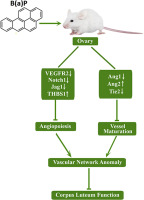Environmental Pollution ( IF 7.6 ) Pub Date : 2020-01-07 , DOI: 10.1016/j.envpol.2020.113915 Min Liu 1 , Ting Deng 1 , Junlin He 1 , Yubin Ding 1 , Xueqing Liu 1 , Hanting Xu 2 , Rufei Gao 1 , Xinyi Mu 2 , Yanqing Geng 2 , Taihang Liu 2 , Yingxiong Wang 2 , Xuemei Chen 1

|
Benzo [a]pyrene (BaP) is a well-known endocrine disruptor. Exposure to BaP is known to impair embryo implantation. The corpus luteum (CL), the primary source of progesterone during early pregnancy, plays a pivotal role in embryo implantation and pregnancy maintenance. The inappropriate luteal function may result in implantation failure and spontaneous abortions. However, the effect of BaP on CL remains unknown. This study investigated the deleterious effects of BaP on the structure and function of CL during early pregnancy. Pregnant rats were dosed with BaP at 0.2 mg.kg-1. d from day 1 (D1) to day 9 (D9) of gestation. We found that BaP reduced the number of CLs, disturbed the secretion of steroid and impacted the luteal vascular networks. BaP significantly decreased the angiogenesis factor (VEGFR, Ang 1 and Tie2) and increased the anti-angiogenic factor THBS1. Inhibited THBS1 function by LSKL partially rescued the angiogenesis defect caused by BaP. In vitro, BaP metabolite BPDE also interfered the expression levels of angiogenesis-related factors in HUVECs and impaired the angiogenesis, whereas supplemented with rAng-1 can alleviate the anti-angiogenic effect of BPDE. Furthermore, Notch signaling molecules, including Notch1, Dll4, Jag1 and Hey2, which are essential for the establishment and maturation of vascular networks, were affected by BaP exposure. Collectively, BaP broke the molecular regulatory balance between luteal angiogenesis and vascular maturation, impaired the construction of luteal vascular networks, and further affected luteal formation and endocrine function during early pregnancy. Our findings might provide new insight into the relationship between BaP and luteal insufficiency in early pregnancy. These data also give a new line of evidence for curtailing BaP emissions and protecting the women of childbearing age from occupational exposure.
中文翻译:

孕早期暴露于苯并[a] py会损害大鼠黄体血管网络。
苯并[a] py(BaP)是众所周知的内分泌干扰物。已知BaP暴露会损害胚胎植入。黄体(CL)是妊娠早期孕酮的主要来源,在胚胎着床和维持妊娠方面起着关键作用。不适当的黄体功能可能会导致植入失败和自然流产。但是,BaP对CL的影响仍然未知。这项研究调查了BaP对妊娠早期CL的结构和功能的有害影响。怀孕大鼠的BaP剂量为0.2 mg.kg-1。d从妊娠第1天(D1)至第9天(D9)。我们发现BaP减少了CL的数量,干扰了类固醇的分泌并影响了黄体血管网络。BaP显着降低了血管生成因子(VEGFR,Ang 1和Tie2)并增加抗血管生成因子THBS1。LSKL抑制THBS1功能可部分挽救BaP引起的血管生成缺陷。在体外,BaP代谢产物BPDE也会干扰HUVEC中血管生成相关因子的表达水平并损害血管生成,而补充rAng-1可以减轻BPDE的抗血管生成作用。此外,Notch信号分子,包括Notch1,Dll4,Jag1和Hey2,对建立和成熟血管网络至关重要,受到BaP暴露的影响。总体而言,BaP破坏了黄体血管生成与血管成熟之间的分子调控平衡,损害了黄体血管网络的构建,并进一步影响了孕早期的黄体形成和内分泌功能。我们的发现可能为早期妊娠中BaP和黄体功能不全之间的关系提供新的见解。这些数据也为减少BaP排放和保护育龄妇女免于职业暴露提供了新的证据。









































 京公网安备 11010802027423号
京公网安备 11010802027423号